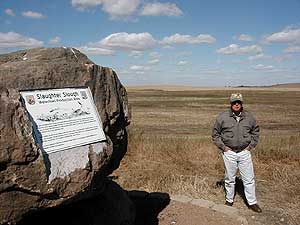|
Audio
Photos
More from MPR
Your Voice
|
1862 war site being restored
September 25, 2003
 |
| A stone monument was dedicated at the site. In the background is Slaughter Slough. Farmers drained the marsh years ago. It's been used since then for row crops or hay. (MPR Photo/Mark Steil) |
Currie, Minn. — For years, rows of corn hid the significance of the field near the small town of Currie. Local historian Bill Bolin told a crowd of more than 200 people at the ceremony that most area residents know little about the spot.
"History is, and always has been, about people and about events that shape our lives. Such as this place that many of you will see for the first time in your lives today," said Bolin.
 | |||
The ordinary field has a colorful name -- Slaughter Slough. In 1862, it was an early battle site when war broke out between Dakota Indians and settlers. The war began after years of broken promises and broken treaties pushed the Indians to rebellion. Bolin says it was a quick, bloody war.
"Anything that we've seen in any war took place here, too. A lot of things are not so pretty to talk about. But that's happened in Iraq, Vietnam, World War I, World War II, I mean all wars," said Bolin.
Hundreds of people were killed. Many settlers died on their farms, and 38 Dakota were hanged in Mankato. In the tall grass of Slaughter Slough, about three dozen settlers tried to hide from the Dakota. Nearly a dozen were killed, along with several Indians.
Descendants from both sides are attracted to the location. At the ceremony Wednesday, Paul Carpenter described the first time he saw the site.
 | |||
"When we reached the edge of the cornfield to look at the slough, it was one of those moments that was almost a sacred moment. It was time to pause and reflect that it was here that my great-grandfather had been shot four times," Carpenter said.
His great-grandfather survived, but the man's sister and two nephews were killed.
The history of the slough is marked now by a plaque attached to three large stones, often called a cairn. The cairn is dedicated to the Indians and settlers in the war.
U.S. Fish and Wildlife Service employees are restoring the uplands to native prairie plants. The agency's Steve Kallin leaned into a fierce wind to tell the crowd that a historical canvass of the site is underway.
 | |||
"This low area that you see mowed here was part of the slough. We mowed the area as a first step, to look for artifacts of the conflict," said Kallin.
So far none have been found, but the search continues. Farmers drained the slough years ago. Eventually it's hoped it can be refilled with water.
Some of the settlers who hid in Slaughter Slough were taken prisoner. Several months after the war ended, a group of Indians risked death to rescue the settlers. The group was known as "Fool Soldiers."
At the ceremony Wednesday, a descendant of the Fool Soldiers, Harry Charger, was on hand. Charger said the events of 1862 are still remembered today. He says some Indians are still bitter the Fool Soldiers helped the settlers.
"We're still being ridiculed to this day. We're being called traitors. We're being looked down upon a lot of times," said Charger. "But we stand tall. Because like I said, if you have compassion in here, their ain't no force in this entire universe that will beat you."
But for most, the bitterness has faded. Dakota and settler descendants at the ceremony called for reconciliation. It was a demonstration of the enduring impact of historical events. Some 141 years and several generations later, both groups are still very aware what happened one August day, in a marsh in southwest Minnesota.
|
News Headlines
|
Related Subjects
|
